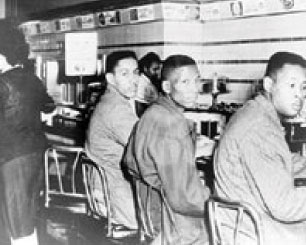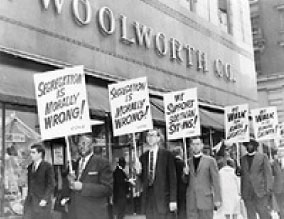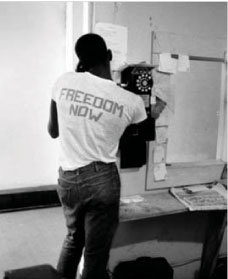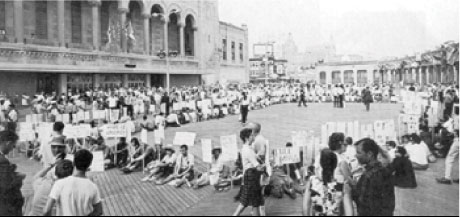Community Organizing Efforts 1960-1964
 |
|
|
The initial sit-in in Greensboro, NC on February 1, 1960. |
After the successful outcome of the Montgomery Bus Boycott in 1956, Martin Luther King Jr. wrote the book Stride Toward Freedom. In the book he explained the crucial roles that both non-violence and direct action played in the success at Montgomery, laying the foundation for the landmark non-violent protests and community organizing efforts of the early 1960s. Two such events that left a lasting impression on the Civil Rights Movement were the Lunch Counter Sit-Ins of 1960 and the Freedom Summer of 1964.
On February 1, 1960, four first-year students from the North Carolina Agricultural and Technical College, Franklin McCain, David Richmond, Joseph McNeil, and Ezell Blair, entered an F. W. Woolworth Company store in Greensboro, North Carolina, sat at the lunch counter and asked to be served. As black men at a segregated lunch counter they knew that they would not be, but they stayed sitting silently at the Woolworth’s until the store closed that evening. The next morning word had spread about their efforts and they returned with media coverage and a growing number of protestors who helped to continue their peaceful sit-in.
 |
|
Picketers protesting the F.W. Woolworth store's policy on lunch counter segregation NY,NY 1960 |
Within two weeks, students in 11 cities held sit-ins. The students always remained non-violent and for these first few weeks were spared any major harassment. Then, on February 27 in Nashville, sit-in students were attacked by a group of White teenagers. When the police arrived they let the White teenagers go and the protesters were arrested for “disorderly conduct”. As students were arrested, new groups of students were there to take their place, and all that were taken in that day were found guilty and fined accordingly. By May of that year, with support of Mayor Ben West, Nashville lunch counters began integrating and serving Blacks.
By August of `60 sit-ins had attracted over 71,000 participants and generated over 3,000 arrests. Within these 6 months the sit-ins had ended restaurant and lunch-counter segregation in twenty-six southern cities. A conference of sit-in students that October resulted in the formation of the Student Nonviolent Coordinating Committee (SNCC) which would prove to be a critical group throughout the rest of the civil rights movement.
 |
In the summer of 1964, a presidential election year, after months of work on voter registration in the southern states, SNCC decided to send volunteers into Mississippi for a voter registration drive. It soon became known as Freedom Summer. The goals of Freedom Summer, outlined by Robert Paris Moses, a leader in the SNCC, were determined: expand black voter registration in Mississippi, organize a constituted “Freedom Democratic Party” (MFDP) to challenge the Whites-only Mississippi Democratic party, and establish Freedom Schools to teach reading and math to black children.
Hundreds of people gathered in the northern states to prepare for the trip to Mississippi. On June 21, the day after the first volunteers left for Mississippi, three workers disappeared. The bodies of Michael Schwerner, Andrew Goodman, and James Chaney were found two months later. All had been shot and James Chaney, the one Black man of the group, had been severely beaten. In the two months the men were missing, Freedom Clinics and Freedom Schools had been established by the other volunteers that had safely made it to Mississippi. The discovery of the bodies, however, breathed new life into the efforts of the SNCC.
Their goal was to take the MFDP to the Democratic National Convention that summer in Atlantic City. The Democratic Party, however, was not convinced that they were entitled to the seats. After long deliberations involving President Johnson and Senator Hubert Humphrey, the party was offered a compromise of two non-voting seats next to the Mississippi delegates. Despite Martin Luther King’s support of the compromise, SNCC refused the Democratic Party’s Offer. They did, however, make a presence at the convention, standing in the place of their removed seats singing freedom songs.
 |
|
|
Atlantic City boardwalk, August 1964. Vigil in support of the MFDP challenge to the Democratic Convention. |
While the MFDP did not fully achieve its goals, it reminded Black people in Mississippi that they could have political awareness and power. In 1964 when their campaign began, 6.7% of voting-aged Blacks in Mississippi were registered to vote, 16.3% below the national average. By 1969, that number jumped to 66.5%, 5.5% above the national average.






